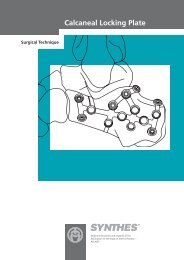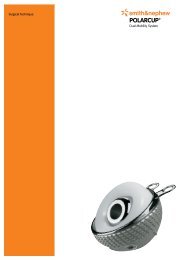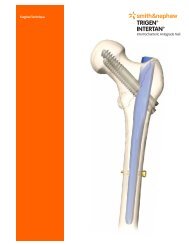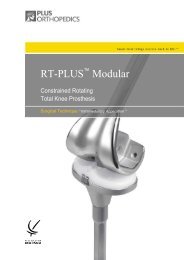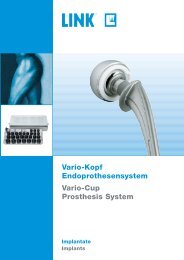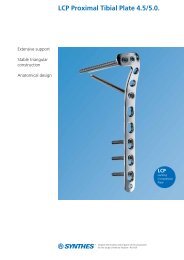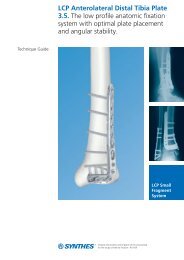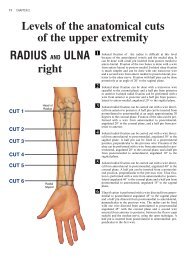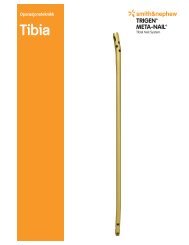LCP Distal Tibia Plate
LCP Distal Tibia Plate
LCP Distal Tibia Plate
- No tags were found...
You also want an ePaper? Increase the reach of your titles
YUMPU automatically turns print PDFs into web optimized ePapers that Google loves.
<strong>LCP</strong> <strong>Distal</strong> <strong>Tibia</strong> <strong>Plate</strong>Surgical Technique<strong>LCP</strong>LockingCompression<strong>Plate</strong>Original Instruments and Implants of theAssociation for the Study of Internal Fixation –AO/ASIF
<strong>LCP</strong> <strong>Distal</strong> <strong>Tibia</strong> <strong>Plate</strong>Table of contentsIndications 3Implants/Instruments 5Surgical technique 6Implant removal 11Image intensifier controlWarningThis description is not sufficient for immediate applicationof the instrumentation. Instruction by a surgeon experiencedin handling this instrumentation is highly recommended.SYNTHES 1
<strong>LCP</strong> <strong>Distal</strong> <strong>Tibia</strong> <strong>Plate</strong>Indications– Extra-articular and simple intra-articular distal tibial fractures– <strong>Distal</strong> tibial fractures, percutaneous or reducible by limitedarthrotomy– <strong>Distal</strong> tibial fracture extending into the diaphyseal areaSYNTHES 3
<strong>LCP</strong> <strong>Distal</strong> <strong>Tibia</strong> <strong>Plate</strong>Implants/Instruments<strong>Plate</strong>s– <strong>LCP</strong> <strong>Distal</strong> <strong>Tibia</strong> <strong>Plate</strong>, 4-hole shaft, right (X39.900)– <strong>LCP</strong> <strong>Distal</strong> <strong>Tibia</strong> <strong>Plate</strong>, 4-hole shaft, left (X39.901)– <strong>LCP</strong> <strong>Distal</strong> <strong>Tibia</strong> <strong>Plate</strong>, 6-hole shaft, right (X39.904)– <strong>LCP</strong> <strong>Distal</strong> <strong>Tibia</strong> <strong>Plate</strong>, 6-hole shaft, left (X39.905)– <strong>LCP</strong> <strong>Distal</strong> <strong>Tibia</strong> <strong>Plate</strong>, 8-hole shaft, right (X39.908)– <strong>LCP</strong> <strong>Distal</strong> <strong>Tibia</strong> <strong>Plate</strong>, 8-hole shaft, left (X39.909)– <strong>LCP</strong> <strong>Distal</strong> <strong>Tibia</strong> <strong>Plate</strong>, 10-hole shaft, right (X39.912)– <strong>LCP</strong> <strong>Distal</strong> <strong>Tibia</strong> <strong>Plate</strong>, 10-hole shaft, left (X39.913)<strong>LCP</strong> locking screws– <strong>LCP</strong> Locking Screw 3.5 mm, self-tapping (X13.010–060)– <strong>LCP</strong> Locking Screw Stardrive ® 3.5 mm, self-tapping(X12.101–124)Standard screw– Cortex Screw 3.5 mm, self-tapping (X04.810–860)Bending instruments– Bending Pin for <strong>LCP</strong> <strong>Plate</strong>s 3.5, with thread (329.916)– Bending Pliers for <strong>Plate</strong>s (391.963)Note: The required <strong>LCP</strong> standard instruments and the requiredsmall fragment instruments are not listed.SYNTHES 5
<strong>LCP</strong> <strong>Distal</strong> <strong>Tibia</strong> <strong>Plate</strong>Surgical technique1Reduce fractureReduce the fragments anatomically and fix temporarily usingKirschner wires.2Insert bone graft (optional)Fill any metaphyseal bone defect with an autogenous bonegraft or bone substitute.3Bend or cut off the distal tabBend the distal tab on the plate using the Bending Pins(329.916) or Bending Pliers (391.963). Alternatively, cut offthe distal tab using the Cutting Pliers for <strong>Plate</strong>s (391.931).Note: Do not repeatedly bend the distal tab back and forth.6
4Insert plateFor the minimal invasive insertion of the plate onto the medialtibia, make a single incision and carefully push the plateunder the soft tissue. Perform stab incisions for the insertionof the screws in the shaft area.5Position and provisionally fix platePosition the plate onto the bone and fix provisionally withKirschner wires. Before inserting the first <strong>LCP</strong> locking screw,ensure that the plate shows good provisional fixation,otherwise the plate may rotate during screw locking andcause soft tissue damage.6Determine screw type and diameterSelect <strong>LCP</strong> locking screws 3.5 mm or cortex screws 3.5 mm.If cortex and <strong>LCP</strong> locking screws are both used in one plate,the cortex screws must be inserted first. This ensures thatthe plate is compressed against the bone before the <strong>LCP</strong> lockingscrews are inserted.AlternativeThe following screws may also be used:– <strong>LCP</strong> Locking Screws 2.7 mm (X02.920–960)– <strong>LCP</strong> Locking Screws Stardrive ® 2.7 mm (X03.920–960)– Cortex Screws 2.7 mm (X02.820–860)– Cancellous Bone Screws 4.0 mm (X07.040–060)Note: For reasons of stability, only use the <strong>LCP</strong> lockingscrews 2.7 mm and the cortex screws 2.7 mm in thedistal section of the plate (round threaded holes).SYNTHES 7
7Predrill screw holesa. When predrilling for standard screws with theUniversal Drill Guide (323.260 or 323.360) and the matchingbit, predrill the screw hole neutrally (1) or off-centre (2).1 2Use the following bits:For cortex screw 3.5 mm and cancellous bone screw 4.0 mm (alternative): Drill Bit 2.5 mm (310.230 or310.250)For cortex screw 2.7 mm (alternative): Drill Bit 2.0 mm(310.190 or 310.210)Note: When using a cortex screw 3.5 mm or 2.7 mm(alternative) as a lag screw, predrill the cortex of the nearbyfragment with a larger bit (Drill Bit 3.5 mm [310.350]for cortex screw 3.5 mm and Drill Bit 2.7 mm [310.260]for cortex screw 2.7 mm).b. When predrilling for <strong>LCP</strong> locking screws, screw the <strong>LCP</strong>Drill Sleeve for <strong>LCP</strong> locking screws 3.5 mm (323.027) or 2.7 mm (312.922) into the desired threaded hole until thesleeve is fully gripped by the thread.The <strong>LCP</strong> drill sleeve ensures that the <strong>LCP</strong> locking screw islocked in the plate in the correct alignment. Angular stabilityis reduced if the <strong>LCP</strong> locking screws are inserted obliquely.Note: Do not bend the plate with the drill sleeve as this maydamage the sleeve. Predrill the screw hole with a suitable bit.Use the following drill bits:For <strong>LCP</strong> locking screw 3.5 mm: Drill Bit 2.8 mm(310.284)For <strong>LCP</strong> locking screw 2.7 mm: Drill Bit 2.0 mm(310.190 or 310.210)8
<strong>LCP</strong> <strong>Distal</strong> <strong>Tibia</strong> <strong>Plate</strong>Surgical technique8Determine screw lengthDetermine the screw length with the Depth Gauge (319.010).60509Insert standard screwsInsert the cortex screws with the small, hexagonal Screwdriver 2.5 mm (314.020).SYNTHES 9
10Insert <strong>LCP</strong> locking screwsa. To insert the <strong>LCP</strong> locking screws mechanically, attach theTorque Limiter 1.5 Nm (511.770) to the power tool unit(Compact Air Drive 511.701 or Power Drive 530.100). Insertthe Hexagonal Screwdriver Shaft (314.030) or theScrewdriver Shaft Stardrive 3.5 (314.116) into the torquelimiter. Pick up the <strong>LCP</strong> locking screw and insert it intothe plate hole. To insert the screw, start the power tool unitslowly, increase the speed and then reduce again beforethe screw is fully tightened. The torque is automatically limitedand a clearly audible click signifies that the maximumlevel has been reached. Stop the power tool unitimmediately and disconnect from the screw.Note: Do not lock the screw at full speed as this risksdamaging the hexagonal or Stardrive recess, making implantremoval more difficult.Ensure that adequate cooling is provided when inserting fairlylong screws into thick cortical bone.With porous bone there is a risk that the <strong>LCP</strong> locking screwwill fail to follow the predrilled hole, resulting in a slightlyoblique hole during mechanical insertion of the screw withsubsequent partial loss of angular stability. In case ofporous bone, manual locking (with the handle for torquelimiter) of the screws is recommended to ensure betterguidance through the predrilled hole.1.5 Nm1.5 Nmb. To insert the <strong>LCP</strong> locking screws manually, attachthe torque limiter 1.5 Nm to the Handle for Torque Limiter(397.705) and insert the screwdriver shaft.Lock the <strong>LCP</strong> locking screws in the plate.10
<strong>LCP</strong> <strong>Distal</strong> <strong>Tibia</strong> <strong>Plate</strong>Implant removalTo remove the plate, first unlock all screws before removingthem definitively in a second step, otherwise the platemay rotate while the last screw is being removed and causesoft tissue damage.If the screws cannot be removed with the screwdriver (e.g. ifthe hexagonal or Stardrive recess of the locking screwsis damaged or if the screws are stuck in the plate), insert theconical Extraction Screw (309.521) with left-handedthread in the screw head using the T-handle with Quick Coupling(311.440) and loosen the locking screw by turningcounterclockwise.SYNTHES 11



